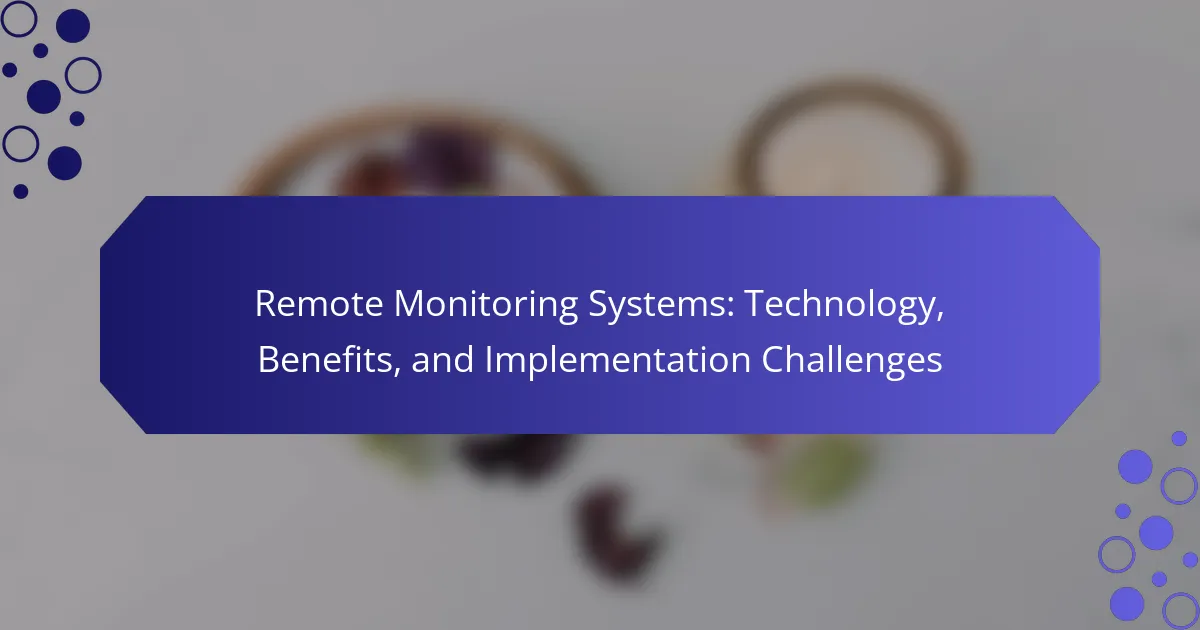Remote monitoring systems offer significant advantages, such as enhanced operational efficiency and improved decision-making. This article explores the technology behind these systems, the benefits they provide across industries like healthcare and agriculture, and the implementation challenges organizations face, including data security and user training. Emerging trends, such as AI integration and wearable devices, are also discussed, highlighting their role in advancing remote monitoring capabilities.
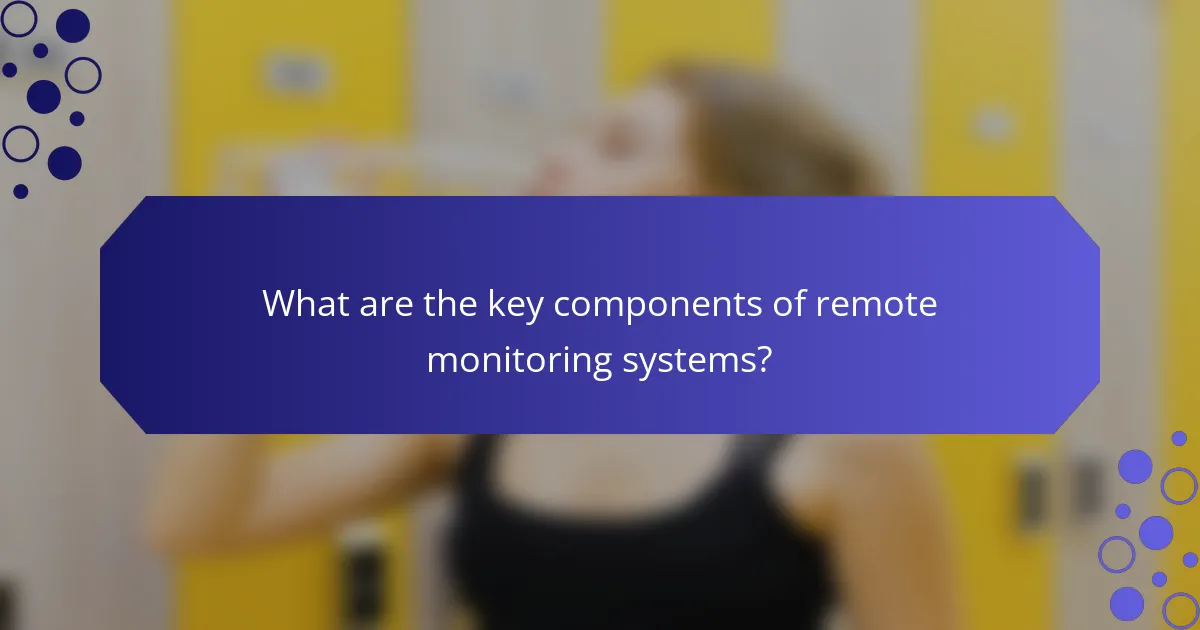
What are the key components of remote monitoring systems?
The key components of remote monitoring systems include sensors, communication networks, data processing units, and user interfaces. Sensors collect data from the environment, while communication networks transmit this data to processing units. Data processing units analyze the information and generate insights, which are then displayed through user interfaces for easy access. These systems enhance efficiency and enable real-time decision-making in various applications.
How do sensors and data collection devices function?
Sensors and data collection devices function by capturing real-time information and transmitting it for analysis. They use various technologies, such as IoT connectivity and wireless communication, to relay data efficiently. These devices can monitor environmental conditions, equipment performance, and user activity, enabling proactive decision-making. The integration of advanced algorithms enhances data interpretation, providing actionable insights for remote monitoring systems.
What role does software play in data analysis and reporting?
Software plays a crucial role in data analysis and reporting by automating data collection, processing, and visualization. It enhances accuracy and efficiency, enabling real-time insights into remote monitoring systems. Key benefits include improved decision-making and streamlined reporting processes. Advanced software can integrate various data sources, facilitating comprehensive analysis and interpretation of data trends. Additionally, user-friendly interfaces allow non-technical users to generate reports and dashboards effectively, fostering a data-driven culture within organizations.
Which communication protocols are commonly used?
Common communication protocols used in remote monitoring systems include MQTT, HTTP/HTTPS, CoAP, and Modbus. These protocols facilitate data transmission between devices and servers, ensuring efficient monitoring and control. MQTT is lightweight, suitable for low-bandwidth environments. HTTP/HTTPS is widely adopted for web-based applications. CoAP is designed for constrained devices, while Modbus is often used in industrial settings for device communication. Each protocol has unique attributes that cater to specific use cases in remote monitoring.
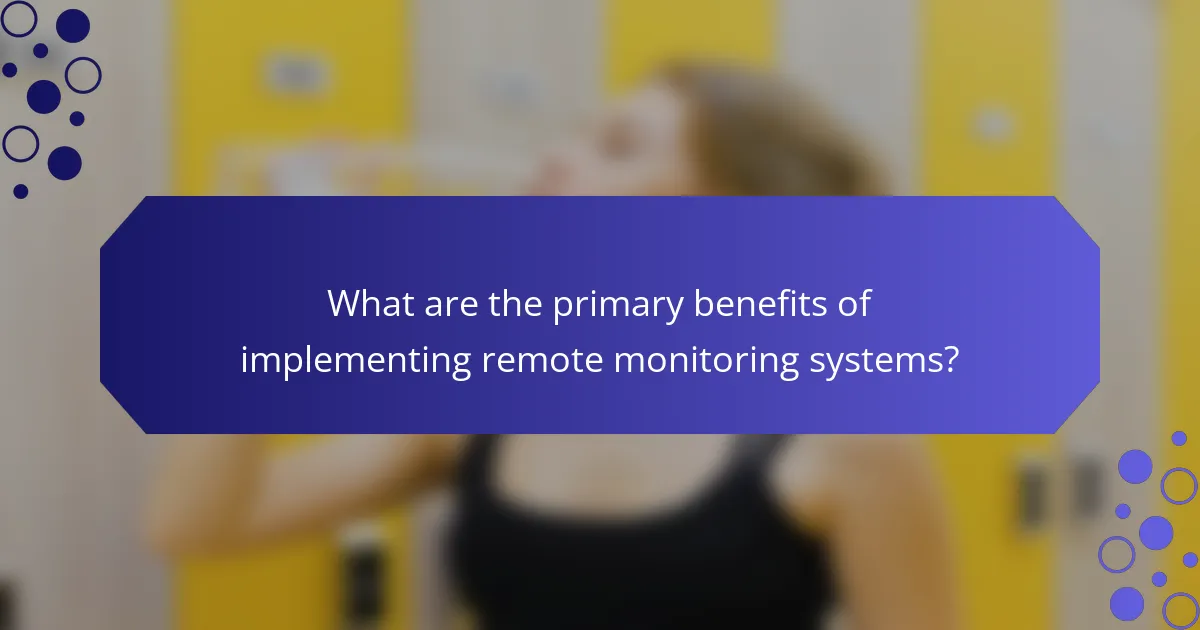
What are the primary benefits of implementing remote monitoring systems?
Implementing remote monitoring systems enhances operational efficiency, reduces costs, and improves patient outcomes. These systems provide real-time data, enabling proactive decision-making and timely interventions. By minimizing the need for in-person visits, they also increase accessibility for patients. Furthermore, remote monitoring can lead to better resource allocation and reduced hospital readmissions, ultimately fostering a more effective healthcare environment.
How do these systems enhance operational efficiency?
Remote monitoring systems enhance operational efficiency by providing real-time data, reducing downtime, and optimizing resource allocation. These systems enable proactive maintenance, allowing organizations to address issues before they escalate. As a result, companies experience improved productivity and cost savings. For example, remote monitoring can reduce equipment failure rates by up to 30%, significantly impacting operational continuity.
What cost savings can organizations expect?
Organizations can expect significant cost savings from remote monitoring systems. These systems reduce operational costs by minimizing the need for on-site personnel and optimizing resource allocation. For example, companies can save up to 30% on labor costs by automating monitoring tasks. Additionally, predictive maintenance enabled by these systems can prevent costly equipment failures, leading to further savings. Overall, the integration of remote monitoring can enhance efficiency and reduce expenses across various operational areas.
How do remote monitoring systems improve safety and compliance?
Remote monitoring systems enhance safety and compliance by providing real-time data and alerts. These systems enable proactive risk management through continuous monitoring of equipment and environments. They help organizations adhere to regulations by ensuring consistent reporting and documentation. Additionally, remote monitoring can reduce human error by automating compliance checks and facilitating timely responses to potential issues. Overall, they create safer workplaces and ensure regulatory adherence efficiently.
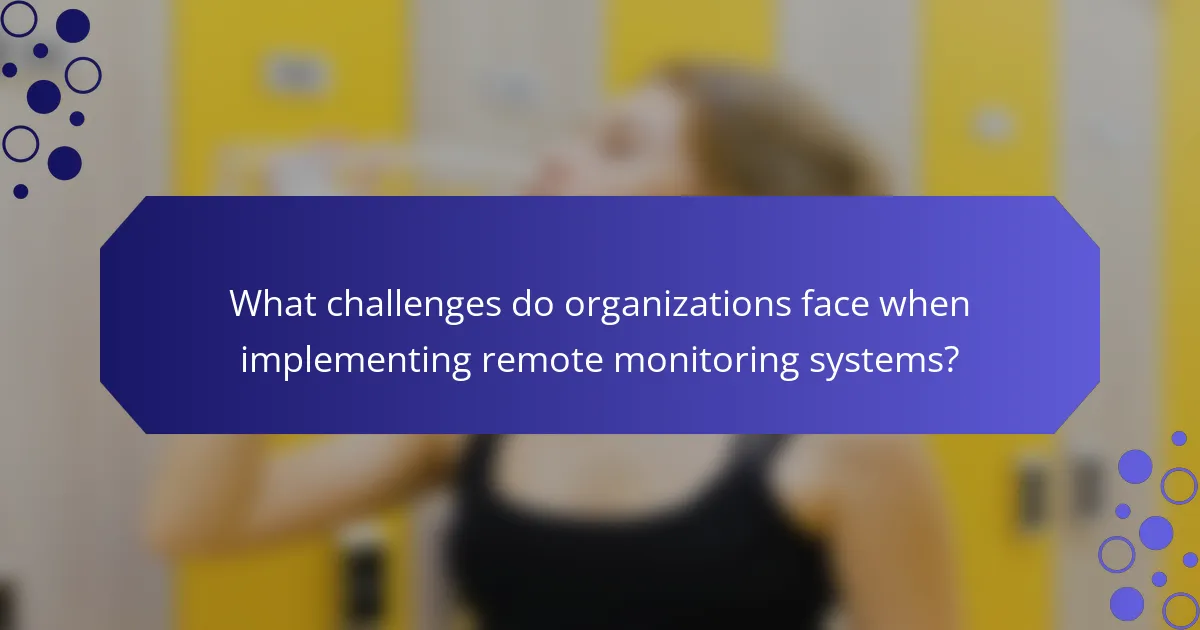
What challenges do organizations face when implementing remote monitoring systems?
Organizations face several challenges when implementing remote monitoring systems, including data security, integration with existing systems, and user training. Data security is a primary concern as sensitive information is transmitted over networks. Integration issues arise when new systems must work with legacy technologies, causing compatibility problems. Additionally, training staff to effectively use these systems can be resource-intensive and time-consuming. As a result, organizations must carefully plan and allocate resources to overcome these hurdles.
What are the common technological hurdles?
Common technological hurdles in remote monitoring systems include data security, interoperability, scalability, and user adoption. Data security concerns stem from potential breaches, risking sensitive information. Interoperability challenges arise when integrating various devices and platforms, leading to compatibility issues. Scalability becomes an issue as systems must handle increasing data volumes and user demands. Lastly, user adoption can be hindered by the complexity of systems and lack of training.
How do organizational culture and training impact implementation success?
Organizational culture and training significantly influence the success of implementing remote monitoring systems. A strong culture that supports innovation fosters employee engagement, leading to smoother integration. Comprehensive training equips staff with necessary skills, reducing resistance and enhancing system utilization. Effective communication of benefits and clear expectations further promotes acceptance and success in implementation.
What are the privacy and security concerns associated with data collection?
Remote monitoring systems raise significant privacy and security concerns due to constant data collection. Unauthorized access to sensitive information can lead to identity theft and misuse of personal data. Data breaches may occur, exposing user information to malicious actors. Additionally, the potential for surveillance raises ethical questions about consent and data ownership. Users may feel their privacy is compromised, leading to distrust in technology. Implementing robust encryption and access controls can mitigate these risks, ensuring data security and user confidence.
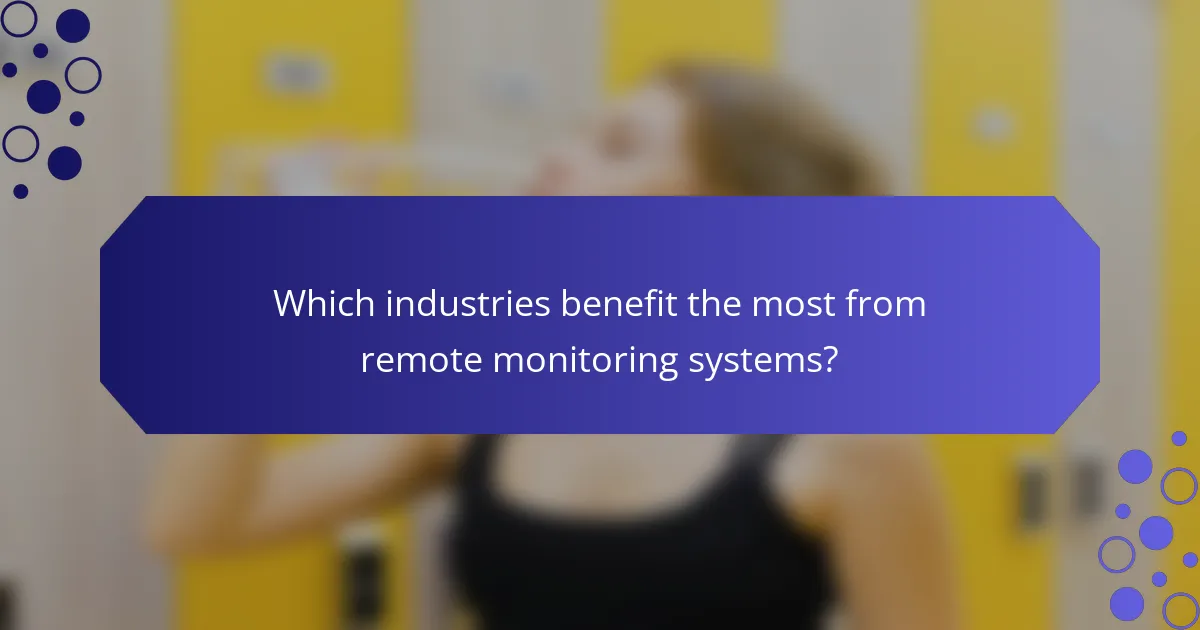
Which industries benefit the most from remote monitoring systems?
Manufacturing, healthcare, agriculture, and logistics benefit the most from remote monitoring systems. These industries leverage real-time data to enhance efficiency, reduce downtime, and improve decision-making.
Manufacturing uses remote monitoring for equipment health, ensuring optimal performance and minimizing failures. Healthcare relies on these systems for patient monitoring, enabling timely interventions. Agriculture benefits through precision farming, optimizing resource use and yield. Logistics enhances supply chain visibility, improving tracking and delivery times.
Each of these sectors experiences unique advantages, such as reduced operational costs and improved safety standards, showcasing the versatile applications of remote monitoring technology.
How are healthcare organizations utilizing these systems?
Healthcare organizations utilize remote monitoring systems to enhance patient care, improve outcomes, and reduce costs. These systems enable continuous tracking of patients’ health metrics, facilitating timely interventions. For example, chronic disease management benefits from real-time data analysis, leading to personalized treatment plans. Additionally, remote monitoring reduces hospital readmissions by allowing healthcare providers to monitor patients’ conditions from home. Integration with electronic health records streamlines data sharing and communication among care teams, further optimizing patient management.
What applications exist in manufacturing and industrial sectors?
Remote monitoring systems are widely used in manufacturing and industrial sectors for real-time data collection and analysis. These systems enhance operational efficiency, reduce downtime, and improve safety by enabling remote oversight of equipment and processes.
Key applications include predictive maintenance, where data from equipment sensors forecast failures before they occur. This approach minimizes unexpected breakdowns and extends machinery lifespan. Additionally, remote monitoring supports quality control by continuously analyzing production metrics, ensuring products meet standards.
Another significant application is energy management. Systems track energy consumption patterns, allowing companies to optimize usage and reduce costs. Furthermore, remote monitoring aids in compliance with regulatory standards by providing accurate records of operational processes and safety measures.
Challenges in implementation often involve integration with existing systems and ensuring data security. Organizations must address these issues to fully leverage the benefits of remote monitoring technologies.
How do remote monitoring systems support environmental monitoring?
Remote monitoring systems enhance environmental monitoring by providing real-time data collection and analysis. These systems utilize sensors to track various environmental parameters, such as air quality, temperature, and water levels. This continuous monitoring allows for timely responses to environmental changes and potential hazards.
Additionally, remote monitoring systems facilitate data sharing among stakeholders, improving collaboration in environmental management. They support compliance with regulations and enhance decision-making processes by offering actionable insights derived from collected data. As a result, organizations can better protect ecosystems and public health.
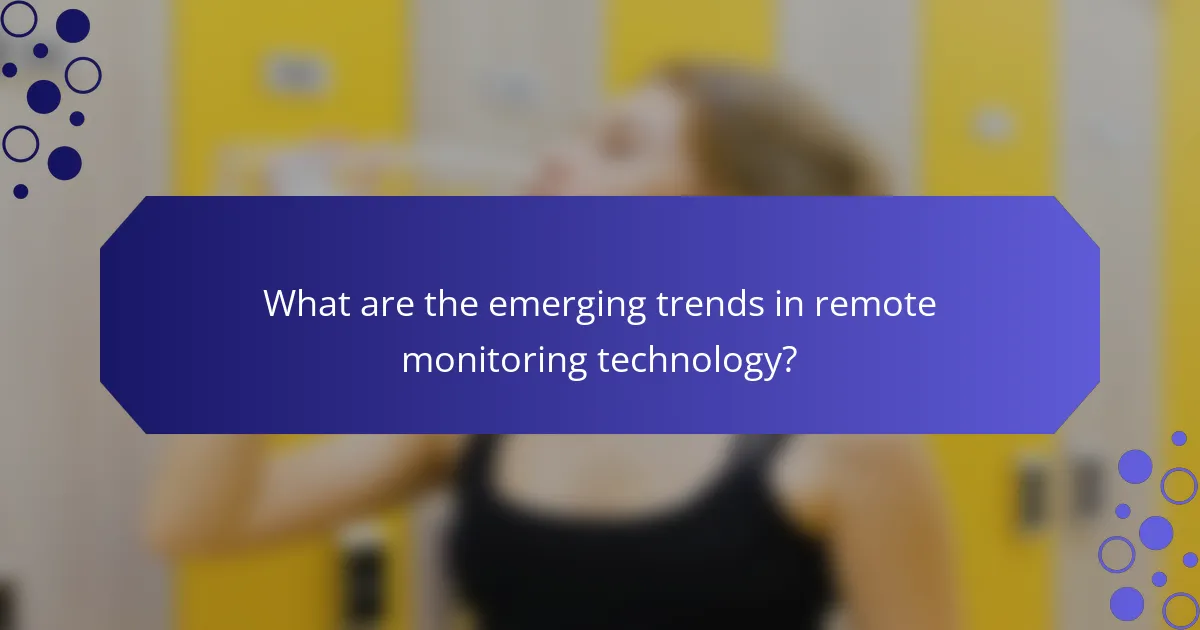
What are the emerging trends in remote monitoring technology?
Emerging trends in remote monitoring technology include the integration of artificial intelligence, enhanced data analytics, and increased use of wearable devices. These advancements improve real-time data collection and patient engagement. AI algorithms analyze vast amounts of data, predicting health issues before they arise. Wearable devices provide continuous monitoring, enabling proactive health management. Additionally, the shift towards cloud-based platforms facilitates seamless data sharing among healthcare providers, enhancing collaboration. Security measures are evolving to protect sensitive patient information, addressing privacy concerns.
How is artificial intelligence enhancing data analysis?
Artificial intelligence significantly enhances data analysis by automating processes, improving accuracy, and uncovering insights. AI algorithms can analyze vast datasets quickly, identifying patterns and trends that would be difficult for humans to detect. This capability leads to more informed decision-making and optimized operations in various sectors. For instance, machine learning models can predict outcomes based on historical data, allowing businesses to anticipate market changes. Additionally, AI tools can continuously learn and adapt, refining their analysis over time, which is a unique attribute that sets them apart from traditional data analysis methods.
What advancements are being made in IoT integration?
Remote monitoring systems are advancing through enhanced connectivity, improved data analytics, and increased automation. These technologies enable real-time monitoring of assets and environments, leading to better decision-making. For example, IoT integration allows for seamless data collection from various sensors, enhancing operational efficiency. However, implementation challenges include data security concerns and the need for standardized protocols.
Which innovative applications are being explored in smart cities?
Remote monitoring systems are being explored in smart cities for enhanced efficiency and sustainability. These systems utilize IoT technology to track environmental data, traffic patterns, and energy usage in real-time.
Key benefits include improved resource management, reduced operational costs, and enhanced public safety. For instance, remote monitoring can optimize waste collection routes, leading to significant savings in fuel and labor.
However, implementation challenges exist. These include data privacy concerns, the need for robust cybersecurity measures, and the integration of diverse technologies across city infrastructures. Addressing these challenges is crucial for successful deployment.
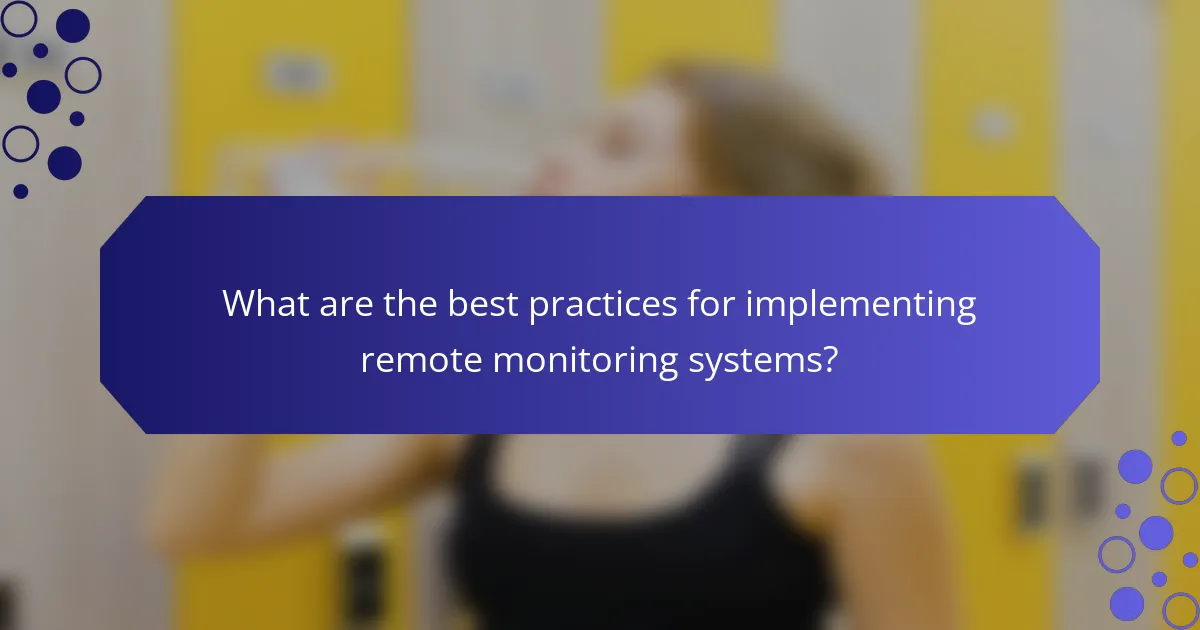
What are the best practices for implementing remote monitoring systems?
To implement remote monitoring systems effectively, focus on clear objectives, robust technology, and user training. Start by defining specific monitoring goals that align with organizational needs. Choose reliable technology that supports data accuracy and real-time access. Ensure proper training for users to maximize system benefits and minimize challenges. Regularly evaluate system performance to adapt and improve the monitoring process.
How can organizations effectively select the right technology?
Organizations can effectively select the right technology by assessing their specific needs and evaluating available solutions. Begin by identifying the primary objectives of remote monitoring systems, such as improving operational efficiency or enhancing safety. Next, consider the scalability of the technology to ensure it can adapt to future growth.
Evaluate the integration capabilities of potential systems with existing infrastructure. Look for user-friendly interfaces and reliable customer support, as these enhance usability and minimize implementation challenges. Additionally, analyze the cost-effectiveness of each option, including both initial investments and long-term maintenance expenses.
Finally, gather feedback from stakeholders and conduct pilot tests to assess real-world performance. This comprehensive approach ensures the chosen technology aligns with organizational goals and operational requirements.
What strategies ensure successful user adoption and training?
Successful user adoption and training of remote monitoring systems rely on clear communication, comprehensive training programs, and ongoing support. Effective strategies include engaging users early, providing hands-on training, and utilizing user feedback to enhance the system.
1. Involve users in the implementation process to build ownership.
2. Offer tailored training sessions that address specific user needs.
3. Create accessible resources, like manuals and video tutorials.
4. Establish a support system for troubleshooting and questions.
5. Encourage a culture of continuous learning to adapt to updates.
How can organizations continuously optimize their monitoring processes?
Organizations can continuously optimize their monitoring processes by leveraging advanced remote monitoring systems. These systems utilize real-time data analytics to identify inefficiencies and enhance decision-making. Regularly updating software and hardware ensures compatibility with the latest technologies. Training staff on new features improves system utilization and effectiveness. Additionally, integrating feedback mechanisms allows for ongoing adjustments based on user experience. Finally, setting clear performance metrics facilitates the measurement of improvements over time.
